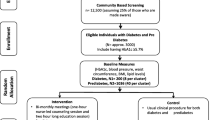Abstract
Background
Limited evidence exists on the impact of nurse practitioner-managed diabetes mellitus care coordination programs in the primary care setting and specifically on the use of telehealth to manage veterans with diabetes in the home.
Objective
To compare the impact of nurse practitioner-based diabetes mellitus care management programs using either a telehealth or a telephone intervention. Specific aims were to (i) compare the efficacy of telehealth and telephone interventions in a diabetes care management program, with regards to glycemic control; (ii) examine the impact of program exposure on the control of diabetes following patient disenrollment from the program; and (iii) identify the average duration of use of a telehealth or telephone intervention required to reach individualized glycemic goals.
Design, setting, and patient population
A retrospective pre-post cohort study of a nurse practitioner-managed diabetes care coordination program was performed in primary care clinics in a Midwest Veterans Administration Medical Center in the US. The cohort included in this study consisted of 259 patients who were enrolled in the program between August 2003 and October 2005 and who disenrolled from the program before January 2006.
Results
The mean reductions in glycosylated hemoglobin (HbA1c) associated with the program were 2.4% for the telehealth intervention (baseline 9.86%; end of program 7.46%) and 2.39% for telephone intervention (baseline 9.75%; end of program 7.36%). No significant difference in the reduction in HbA1c was noted between telehealth and telephone interventions (p = 0.96) after adjusting for baseline HbA1c and age.
The number of days of participation in the program was greater for the telehealth group than the group receiving the telephonic intervention (192.2 vs 161.9) but this difference was not statistically significant (p = 0.13). Approximately 75% of the patients (n = 192) worked with nurse practitioners and had reached individualized glycemic goals at disenrollment. Among these patients, those receiving the telehealth intervention had a 3.1% (SD = 1.9, p < 0.001) reduction in HbA1c and those receiving the telephone intervention had a 2.7% (SD = 1.9, p < 0.001) reduction in HbA1c, over a mean period of 204 days.
Both interventions lost some of their effect following program disenrollment. The mean rise in HbA1c in the post-program period was 0.69% for the telehealth intervention and 0.63% for the telephone intervention (the average number of post-program days was 434 days for the telehealth intervention and 323 days for the telephone intervention). After adjusting for HbA1c at disenrollment and the number of days between disenrollment and the latest HbA1c measurement, no significant difference in the rise in HbA1c was seen between the two interventions (p = 0.80).
Conclusion
When employed for a comparable number of days, telehealth and telephone communication technologies used by nurse practitioners to provide individualized diabetes care management have similar effects on glycemic control. After disenrollment, HbA1c increased slightly, suggesting that veterans need continuous individualized care, in addition to routine follow-up, to manage their diabetes.



Similar content being viewed by others
References
Stratton IM, Adler AI, Neil HA, et al. Association of glycaemia with macrovascular and microvascular complications of type 2 diabetes (UKPDS 35): prospective observational study. BMJ 2000 Aug 12; 321(7258): 405–12
Testa MA, Simonson DC. Health economic benefits and quality of life during improved glycemic control in patients with type 2 diabetes mellitus: a randomized, controlled, double-blind trial. JAMA 1998 Nov 4; 280(17): 1490–6
American Diabetes Association. Clinical practice recommendations. Diabetes Care 2007 Jan; 30 (Suppl. 1): S1–103
Mitka M. Diabetes management remains suboptimal: even academic centers neglect curbing risk factors. JAMA 2005 Apr 20; 293(15): 1845–6
Rundall TG, Shortell SM, Wang MC, et al. As good as it gets? Chronic care management in nine leading US physician organisations. BMJ 2002 Oct 26; 325(7370): 958–61
Vijan S, Hayward RA, Ronis DL, et al. Brief report: the burden of diabetes therapy. Implications for the design of effective patient-centered treatment regimens. J Gen Intern Med 2005 May; 20(5): 479–82
Knight K, Badamgarav E, Henning JM, et al. A systematic review of diabetes disease management programs. Am J Manag Care 2005 Apr; 11(4): 242–50
Loveman E, Royle P, Waugh N. Specialist nurses in diabetes mellitus. Cochrane Database of Systematic Reviews 2003; (2): CD003286
Mullen BA, Kelley PAW. Diabetes nurse case management: an effective tool. J Am Acad Nurse Pract 2006 Jan; 18(1): 22–30
Taylor CB, Miller NH, Reilly KR, et al. Evaluation of a nurse-care management system to improve outcomes in patients with complicated diabetes. Diabetes Care 2003; 26(4): 1058–63
Shojania KG, Ranji SR, McDonald KM, et al. Effects of quality improvement strategies for type 2 diabetes on glycemic control: a meta-regression analysis. JAMA 2006 Jul; 296(4): 427–40
Chumbler NR, Vogel WB, Garel M, et al. Health services utilization of a care coordination/home-telehealth program for veterans with diabetes: a matchedcohort study. J Ambulat Care Manag 2005 Jul–Sep; 28(3): 230–40
Shea S, Weinstock RS, Starren J, et al. A randomized trial comparing telemedicine case management with usual care in older, ethnically diverse, medically underserved patients with diabetes mellitus. J Am Med Informatics Assoc 2006 Jan–Feb; 13(1): 40–51
Noel HC, Vogel DC, Erdos JJ, et al. Home telehealth reduces healthcare costs. Telemed J E-Health 2004; 10(2): 170–83
Joseph AM. Care coordination and telehealth technology in promoting self-management among chronically ill patients. Telemed J E-Health 2006 Apr; 12(2): 156–9
Krein SL, Klamerus ML, Vijan S, et al. Case management for patients with poorly controlled diabetes: a randomized trial. Am J Med 2004 Jun 1; 116(11): 732–9
Miller DR, Safford MM, Pogach LM. Who has diabetes? Best estimates of diabetes prevalence in the Department of Veterans Affairs based on computerized patient data. Diabetes Care 2004 May; 27 Suppl. 2: B10–21
Reiber GE, Koepsell TD, Maynard C, et al. Diabetes in nonveterans, veterans, and veterans receiving Department of Veterans Affairs health care. Diabetes Care 2004 May; 27 Suppl. 2: B3–9
United States Department of Veterans Affairs, Office of Care Coordination. Care coordination/home telehealth (CCHT) in VA and what it means for veteran patients. 2007 Jan 16 [online]. Available from URL: http://www.va.gov/occ/VetCCHT.asp [Accessed 2007 Mar 17]
Diabetes Mall. Health through information: rules for control [online]. Available from URL: http://www.diabetesnet.com/diabetes_control_tips/corr_factor.php [Accessed 2007 Nov 7]
Walsh J, Warma C, Bailey T. Using insulin. San Diego (CA): Torrey Pines Press, 2003
Krumholz HM, Currie PM, Riegel B, et al. A taxonomy for disease management: a scientific statement from the American Heart Association Disease Management Taxonomy Writing Group. Circulation 2006 Sep 26; 114(13): 1432–5
The California Medi-Cal Type 2 Diabetes Study Group. Closing the gap: effect of diabetes case management on glycemic control among low-income ethnic minority populations. The California Medi-Cal Type 2 Diabetes Study. Diabetes Care 2004 Jan; 27(1): 95–103
Chumbler NR, Vogel WB, Garel M, et al. Health services utilization of a care coordination/home-telehealth program for veterans with diabetes. J Ambulat Care Manag 2005 Jul–Sep; 28(3): 230–40
Marrero DG. Changing patient behavior. Endocr Pract 2006 Jan–Feb; 12 Suppl. 1: 118–20
Acknowledgments
This study received no funding support. Dr Karen Chang completed this study during her postdoctoral fellowship at VA Health Service Research Department. Peter Woodbridge received partial funding for the development of the diabetes telehealth module in collaboration with American Telecare, Inc. The other authors have no conflicts of interest that are directly relevant to the contents of this study.
The authors acknowledge Betty Dameron, Associate Chief Nursing Service for Clinical Operations at Roudebush VA Medical Center for her initiation of the nurse practitioner-based diabetes care management program, Dr James Walsh for providing prompt endocrinology consultation, and Dr Laura Sands for statistical consultation.
Author information
Authors and Affiliations
Corresponding author
Rights and permissions
About this article
Cite this article
Chang, K., Davis, R., Birt, J. et al. Nurse Practitioner-Based Diabetes Care Management. Dis-Manage-Health-Outcomes 15, 377–385 (2007). https://doi.org/10.2165/00115677-200715060-00005
Published:
Issue Date:
DOI: https://doi.org/10.2165/00115677-200715060-00005




